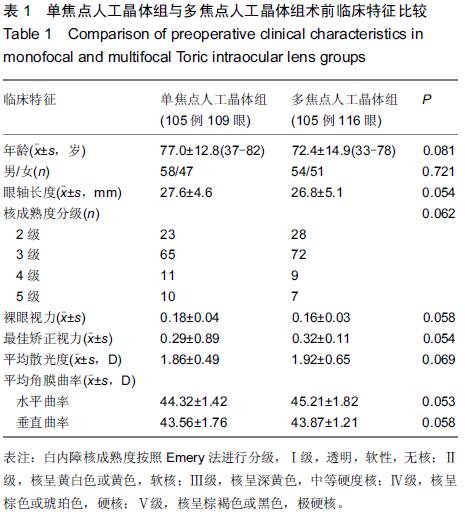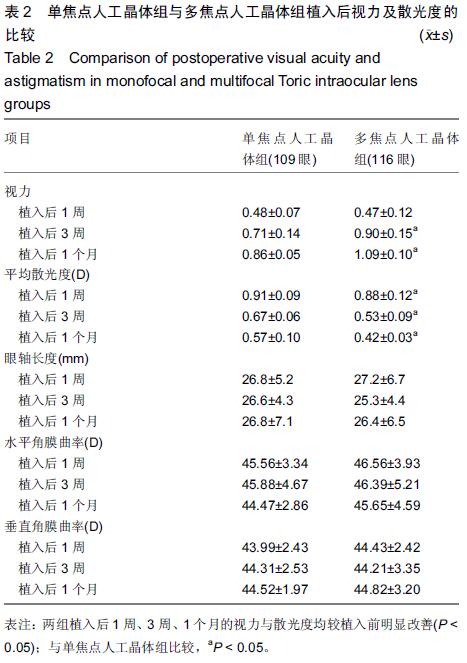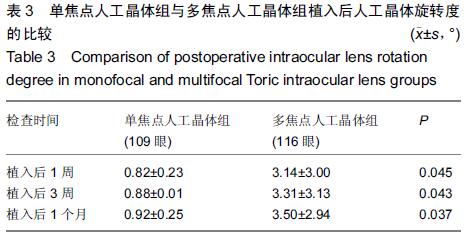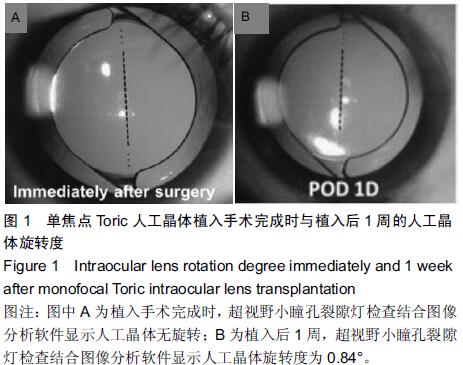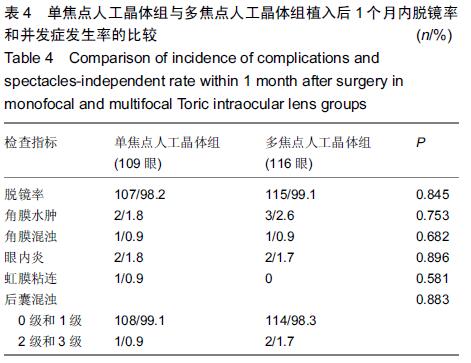| [1] Pascolini D,Mariotti SP.Global estimates of visual impairment: 2010.Br J Ophthalmol.2012;96(5):614-618.
[2] 郑宏,于普林,洪依舒,段春波,杨泽,高芳坤.我国城乡老年人白内障的患病情况调查[J].中华流行病学杂志,2001,22(6):6446- 6448.
[3] Hoffer KJ.Biometry of 7,500 cataractous eyes.Am J Ophthalmol.1980;90:360-368.
[4] Hoffmann PC,Hütz WW.Analysis of biometry and prevalence data for corneal astigmatism in 23,239 eyes.J Cataract Refract Surg.2010;36:1479-1485.
[5] Ferrer-Blasco T,Montés-Micó R,Peixoto-de-Matos SC,et al.Prevalence of corneal astigmatism before cataract surgery. J Cataract Refract Surg.2009;35:70-75.
[6] 赵江月,张劲松.散光人工晶状体在白内障摘除手术中的应用[J].国际眼科纵览,2008,31(4):258-260.
[7] 袁建树,马蓉,王育文.AcrysofToric人工晶状体矫正角膜散光的临床研究[J].现代实用医学,2012,23(12):1330-1336.
[8] 胡铮,赵家良,董方田,等.北京市顺义县白内障流行病学调查[J].中华眼科杂志,1989,25(6):360-364.
[9] Visser N, Beckers HJ, Bauer NJ,et al.Toric vs aspherical control intraocular lenses in patients with cataract and corneal astigmatism: a randomized clinical trial.JAMA Ophthalmol. 2014;132(12):1462-1468.
[10] Miyake T,Kamiya K,Amano R,et al.Long-term clinical outcomes of toric intraocular lens implantation in cataract cases with preexisting astigmatism.J Cataract Refract Surg. 2014;40(10):1654-1660.
[11] Shimoda T,Shimoda G,Hida WT,et al.Visual outcomes after implantation of a novel refractive toric multifocal intraocular lens.Arq Bras Oftalmol.2014;77(2):71-75.
[12] Holland E,Lane S,Horn JD,et al.The AcrySoftoric intraocular lens in subjects with cataracts and corneal astigmatism; a randomized, subject-masked, parallelgroup, 1-year study. Ophthalmology.2010;117:2104-2111.
[13] Freitas GO,Boteon JE,Carvalho MJ,et al.Treatment of astigmatism during phacoemulsification.Arq Bras Oftalmol. 2014;77(1):40-46.
[14] Maedel S,Hirnschall N,Chen YA,et al.Rotational performance and corneal astigmatism correction during cataract surgery: aspheric toric intraocular lens versus aspheric nontoric intraocular lens with opposite clear corneal incision.J Cataract Refract Surg. 2014;40(8):1355-1362.
[15] Bellucci R,Bauer NJ,Daya SM,et al.Visual acuity and refraction with a diffractive multifocal toric intraocular lens.J Cataract Refract Surg.2013;39(10):1507-1518.
[16] Visser N,Ru?z-Mesa R,Pastor F,et al.Cataract surgery with toric intraocular lens implantation in patients with high corneal astigmatism.J Cataract Refract Surg.2011;37:1403-1410.
[17] Gayton JL,Seabolt RA.Clinical outcomes of complex and uncomplicated cataractous eyes after lens replacement with the AcrySoftoricIOL.J Refract Surg.2011; 27:56-62.
[18] Hasegawa Y,Okamoto F,Nakano S,et alT.Effect of preoperative corneal astigmatism orientation on results with a toric intraocular lens.J Cataract Refract Surg.2013;39(12): 1846-1851.
[19] Venkataraman A; Kalpana.Visual outcome and rotational stability of open loop toric intraocular lens implantation in Indian eyes.Indian J Ophthalmol.2013;61(11):626-629.
[20] Iovieno A,Yeung SN,Lichtinger A,et al.Cataract surgery with toric intraocular lens for correction of high corneal astigmatism.Can J Ophthalmol.2013;48(4):246-250.
[21] Lee JY,Kang KM,Shin JP,et al.Two-year results of AcrySof toric intraocular lens implantation in patients with combined microincision vitrectomy surgery and phacoemulsification.Br J Ophthalmol.2013;97(4):444-449.
[22] Alió JL,Peña-García P,Abdulla Guliyeva F,et al.MICS with toric intraocular lenses in keratoconus: outcomes and predictability analysis of postoperative refraction.Br J Ophthalmol.2014;98(3):365-370.
[23] Einan-Lifshitz A,Barkana Y,Goldich Y,et al.Results of cataract surgery with Z-flex hydrophilic acrylic toric IOL.Eur J Ophthalmol. 2013;23(3):333-338.
[24] Lyall DA,Srinivasan S,Ng J,et al.Changes in corneal astigmatism among patients with visually significant cataract.Can J Ophthalmol.2014;49(3):297-303.
[25] Roensch MA,Charton JW,Blomquist PH,et al.Resident experience with toric and multifocal intraocular lenses in a public county hospital system.J CataractRefract Surg.2012; 38:793-798.
[26] Scialdone A,De Gaetano F,Monaco G.Visual performance of 2 aspheric toric intraocular lenses: comparative study.J Cataract Refract Surg.2013;39(6):906-914.
[27] Ferreira TB, Marques EF, Rodrigues A, Montés-Micó R.Visual and optical outcomes of a diffractive multifocal toric intraocular lens.J Cataract Refract Surg.2013;39(7):1029-1035.
[28] 郑登易,叶剑,谭薇.多焦点、可调节和单焦点人工晶状体临床视觉质量的观察[J].第三军医大学学报,2012,34(4):354-357.
[29] 叶盼盼,姚克,李霞,等.双眼植入Tecnis多焦点和单焦点球面人工晶状体的临床比较研究[J].中华眼科杂志,2010,46(7):625-630.
[30] Felipe A,Artigas JM,Díez-Ajenjo A,García-Domene C,et al.Residual astigmatism produced by toric intraocular lens rotation.J Cataract Refract Surg.2011;37(10):1895-1901.
[31] Prinz A,Neumayer T,Buehl W,et al.Rotational stability and posterior capsule opacification of a plate-haptic and anopen-l oop-haptic intraocular lens.J Cataract Refract Surg.2011; 37: 251-257.
[32] Lombardo M,Carbone G,Lombardo G,et al.Analysis of intraocular lens surface adhesiveness by atomic force microscopy.J Cataract Refract Surg.2009;35:1266-1272.
[33] Oshika T,Nagata T,Ishii Y.Adhesion of lens capsule to intraocular lenses of polymethylmethacrylate, silicone, and acrylic foldable materials: an experimental study.Br J Ophthalmol.1998;82:549-553.
[34] Linnola RJ,Sund M,Ylönen R,et al.Adhesion of soluble fibronectin, vitronectin, and collagen type IV to intraocular lens materials.J Cataract Refract Surg.2003;29(1):146-152.
[35] Linnola RJ,Werner L,Pandey SK,et al.Adhesion of fibronectin, vitronectin, laminin,and collagen type IV to intraocular lens materials in pseudophakichuman autopsy eyes. Part 1: histological sections.J Cataract Refract Surg.2000;26:1792-1806.
[36] Krall EM,Arlt EM,Jell G,et al.Prospective Randomized Intraindividual Comparison of Posterior Capsule Opacification After Implantation of an IOL With and Without Heparin Surface Modification.J Refract Surg.2015;31(7):466-472.
[37] Krall EM,Arlt EM,Jell G,et al.Intraindividual aqueous flare comparison after implantation of hydrophobic intraocular lenses with or without a heparin-coated surface.J Cataract Refract Surg.2014;40(8):1363-1370.
[38] Shah GD,Praveen MR,Vasavada AR,Vasavada VA,et al. Rotational stability of a toric intraocular lens: influence of axial length and alignment in the capsular bag. J Cataract Refract Surg.2012;38:54-59.
[39] Prinz A,Neumayer T,Buehl W,et al.Rotational stability and posterior capsule opacification of a plate-haptic and an open-loop-haptic intraocular lens. J Cataract Refract Surg. 2011; 37:251-257. |
